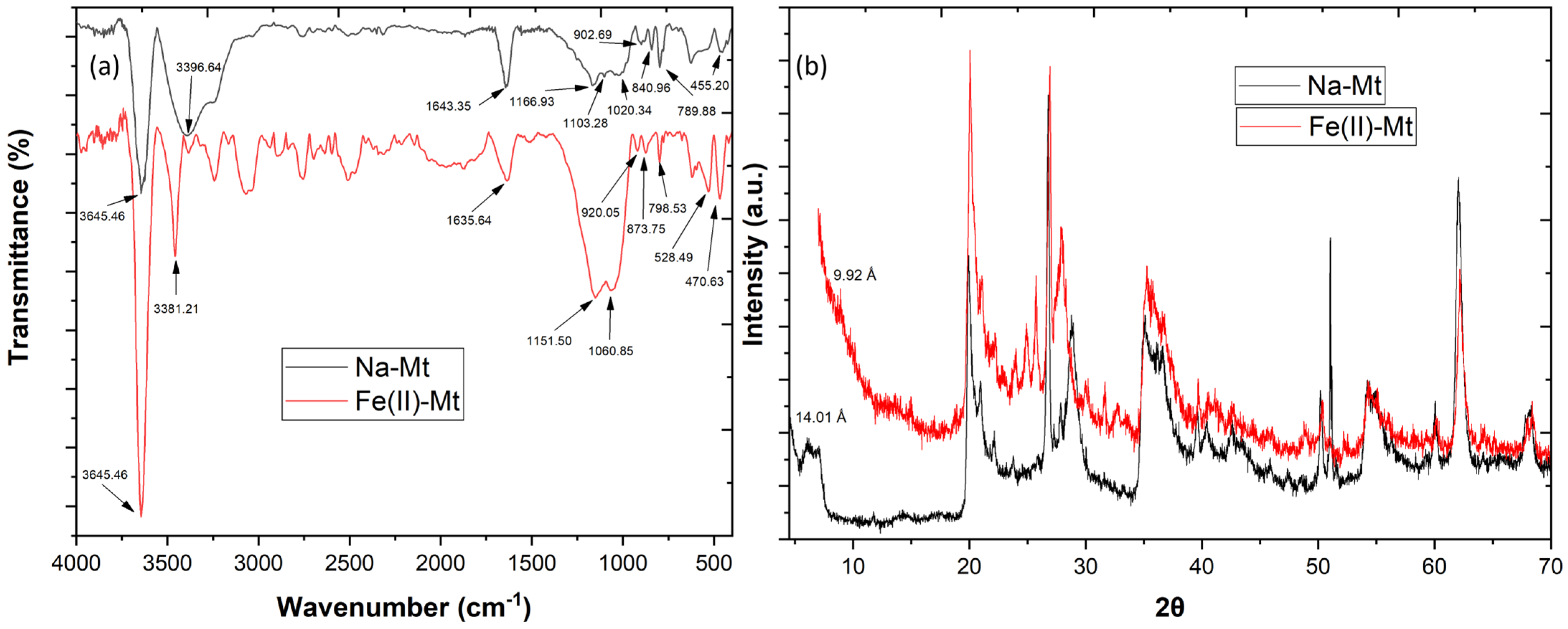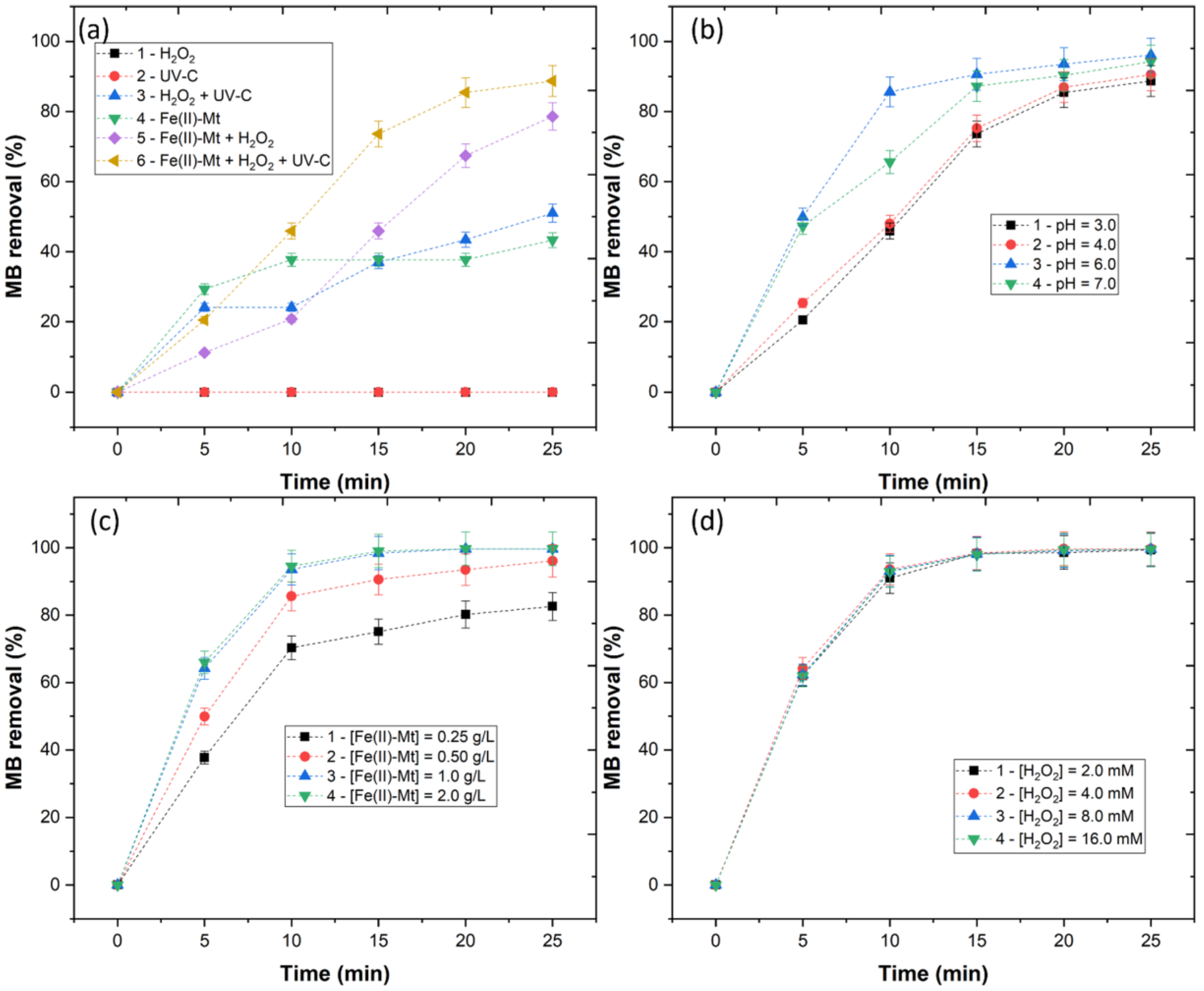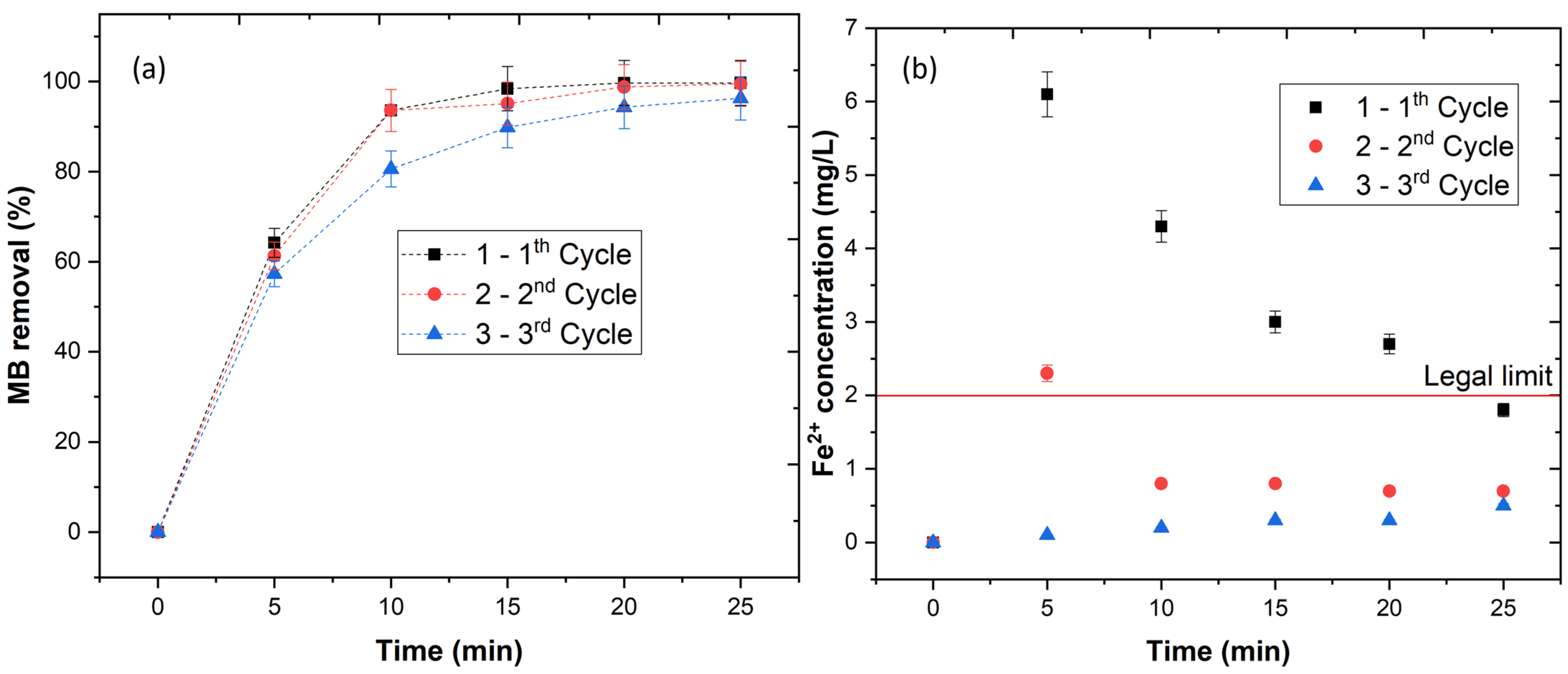Heterogeneous Photo-Fenton Oxidation of Methylene Blue Solution Using Fe(II)-Montmorillonite Calcinated Clay Catalyst †
Abstract
1. Introduction
2. Materials and Methods
2.1. Reagents
2.2. Analytic Techniques
2.3. Catalyst Fe(II)-Mt Calcinated Clay Preparation
2.4. Heterogeneous Fenton-Based Experiments
3. Results and Discussion
3.1. Characterization of Fe-BC Catalyst
3.2. MB Degradation by Heterogeneous Fenton-Based Processes
4. Conclusions
Author Contributions
Funding
Institutional Review Board Statement
Informed Consent Statement
Data Availability Statement
Conflicts of Interest
References
- Berradi, M.; Hsissou, R.; Khudhair, M.; Assouag, M.; Cherkaoui, O.; El, A.; El, A. Textile Finishing Dyes and Their Impact on Aquatic Environs. Heliyon 2019, 5, e02711. [Google Scholar] [CrossRef]
- Bhatia, D.; Sharma, N.R.; Singh, J.; Kanwar, R.S. Biological Methods for Textile Dye Removal from Wastewater: A Review. Crit. Rev. Environ. Sci. Technol. 2017, 47, 1836–1876. [Google Scholar] [CrossRef]
- Jorge, N.; Santos, C.; Teixeira, A.R.; Marchão, L.; Tavares, P.B.; Lucas, M.S.; Peres, J.A. Treatment of Agro-Industrial Wastewaters by Coagulation-Flocculation-Decantation and Advanced Oxidation Processes—A Literature Review. Eng. Proc. 2022, 19, 33. [Google Scholar] [CrossRef]
- Jorge, N.; Teixeira, A.R.; Lucas, M.S.; Peres, J.A. Combined Organic Coagulants and Photocatalytic Processes for Winery Wastewater Treatment. J. Environ. Manag. 2023, 326, 116819. [Google Scholar] [CrossRef]
- Tokumura, M.; Morito, R.; Hatayama, R.; Kawase, Y. Iron Redox Cycling in Hydroxyl Radical Generation during the Photo-Fenton Oxidative Degradation: Dynamic Change of Hydroxyl Radical Concentration Fe (II) Compounds Fe (III) Compounds. Appl. Catal. B Environ. 2011, 106, 565–576. [Google Scholar] [CrossRef]
- Herney-ramirez, J.; Silva, A.M.T.; Vicente, M.A.; Costa, C.A.; Madeira, L.M. Degradation of Acid Orange 7 Using a Saponite-Based Catalyst in Wet Hydrogen Peroxide Oxidation: Kinetic Study with the Fermi’s Equation. Appl. Catal. B Environ. 2011, 101, 197–205. [Google Scholar] [CrossRef]
- Paulino, T.R.S.; Araújo, R.d.S.; Salgado, B.C.B. Study of Advanced Oxidation of Basic Dyes by Fenton Reaction (Fe2+/H2O2). Eng. Sanit. e Ambient. 2015, 20, 347–352. [Google Scholar] [CrossRef]
- Teixeira, A.R.; Jorge, N.; Fernandes, J.R.; Lucas, M.S.; Peres, J.A. Textile Dye Removal by Acacia Dealbata Link. Pollen Adsorption Combined with UV-A/NTA/Fenton Process. Top. Catal. 2022, 1–17. [Google Scholar] [CrossRef]
- Jorge, N.; Teixeira, A.R.; Matos, C.C.; Lucas, M.S.; Peres, J.A. Combination of Coagulation–Flocculation–Decantation and Ozonation Processes for Winery Wastewater Treatment. Int. J. Environ. Res. Public Health 2021, 18, 8882. [Google Scholar] [CrossRef] [PubMed]
- Hassan, H.; Hameed, B.H. Fe–Clay as Effective Heterogeneous Fenton Catalyst for the Decolorization of Reactive Blue 4. Chem. Eng. J. 2011, 171, 912–918. [Google Scholar] [CrossRef]
- Jorge, N.; Teixeira, A.R.; Lucas, M.S.; Peres, J.A. Combination of Adsorption in Natural Clays and Photo-Catalytic Processes for Winery Wastewater Treatment. In Advances in Geoethics and Groundwater Management: Theory and Practice for a Sustainable Development; Abrunhosa, M., Chambel, A., Peppoloni, S., Chaminé, H.I., Eds.; Springer: Cham, Switzerland, 2021; pp. 291–294. ISBN 978-3-030-59320-9. [Google Scholar]
- Jorge, N.; Teixeira, A.R.; Guimarães, V.; Lucas, M.S.; Peres, J.A. Treatment of Winery Wastewater with a Combination of Adsorption and Thermocatalytic Processes. Processes 2022, 10, 75. [Google Scholar] [CrossRef]
- Ribeiro, J.P.; Marques, C.C.; Portugal, I.; Nunes, M.I. Fenton Processes for AOX Removal from a Kraft Pulp Bleaching Industrial Wastewater: Optimisation of Operating Conditions and Cost Assessment. J. Environ. Chem. Eng. 2020, 8, 104032. [Google Scholar] [CrossRef]
- Flores, Y.; Flores, R.; Gallegos, A.A. Heterogeneous Catalysis in the Fenton-Type System Reactive Black 5/H2O2. J. Mol. Catal. A Chem. 2008, 281, 184–191. [Google Scholar] [CrossRef]
- Guimarães, V.; Teixeira, A.R.; Lucas, M.S.; Silva, A.M.T.; Peres, J.A. Pillared Interlayered Natural Clays as Heterogeneous Photocatalysts for H2O2-Assisted Treatment of a Winery Wastewater. Sep. Purif. Technol. 2019, 228, 115768. [Google Scholar] [CrossRef]
- Silva, A.M.T.; Herney-ramirez, J.; Söylemez, U.; Madeira, L.M. A Lumped Kinetic Model Based on the Fermi’s Equation Applied to the Catalytic Wet Hydrogen Peroxide Oxidation of Acid Orange 7. Appl. Catal. B Environ. 2012, 121–122, 10–19. [Google Scholar] [CrossRef]



| Name | Chemical Structure | λmax (nm) | Molecular Weight (g/mol) |
|---|---|---|---|
| Methylene blue (azo dye) |  | 665, 300 and 250 nm | 319.85 |
Disclaimer/Publisher’s Note: The statements, opinions and data contained in all publications are solely those of the individual author(s) and contributor(s) and not of MDPI and/or the editor(s). MDPI and/or the editor(s) disclaim responsibility for any injury to people or property resulting from any ideas, methods, instructions or products referred to in the content. |
© 2022 by the authors. Licensee MDPI, Basel, Switzerland. This article is an open access article distributed under the terms and conditions of the Creative Commons Attribution (CC BY) license (https://creativecommons.org/licenses/by/4.0/).
Share and Cite
Jorge, N.; Teixeira, A.R.; Lucas, M.S.; Peres, J.A. Heterogeneous Photo-Fenton Oxidation of Methylene Blue Solution Using Fe(II)-Montmorillonite Calcinated Clay Catalyst. Eng. Proc. 2023, 31, 67. https://doi.org/10.3390/ASEC2022-13813
Jorge N, Teixeira AR, Lucas MS, Peres JA. Heterogeneous Photo-Fenton Oxidation of Methylene Blue Solution Using Fe(II)-Montmorillonite Calcinated Clay Catalyst. Engineering Proceedings. 2023; 31(1):67. https://doi.org/10.3390/ASEC2022-13813
Chicago/Turabian StyleJorge, Nuno, Ana R. Teixeira, Marco S. Lucas, and José A. Peres. 2023. "Heterogeneous Photo-Fenton Oxidation of Methylene Blue Solution Using Fe(II)-Montmorillonite Calcinated Clay Catalyst" Engineering Proceedings 31, no. 1: 67. https://doi.org/10.3390/ASEC2022-13813
APA StyleJorge, N., Teixeira, A. R., Lucas, M. S., & Peres, J. A. (2023). Heterogeneous Photo-Fenton Oxidation of Methylene Blue Solution Using Fe(II)-Montmorillonite Calcinated Clay Catalyst. Engineering Proceedings, 31(1), 67. https://doi.org/10.3390/ASEC2022-13813








